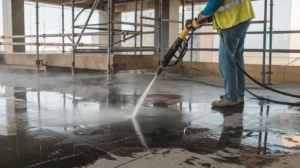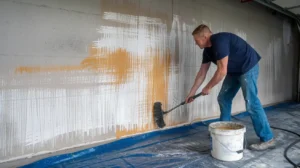Granite countertops are a beautiful and durable addition to any kitchen or bathroom, but they can occasionally become stained. Knowing how to remove stains from granite countertops is essential for maintaining their pristine appearance. The best way to clean granite countertops involves using the right cleaning solutions and techniques.
To effectively remove the stain, start by identifying the type of stain and choosing a suitable cleaner. Whether it’s oil, wine, or coffee, there are specific methods to tackle each. With the right approach, you can keep your granite counters looking as good as new.

Materials Needed to remove stains from granite countertops
1.Granite Cleaner
2.Mild Dish Soap
3.Baking Soda
4.Hydrogen Peroxide
5.White Vinegar
6.Rubbing Alcohol
7.Soft Cloths
8.Plastic Wrap
9.Water
10.Granite Sealer
How to Remove Oil Stains
To remove oil stains from granite countertops, start by choosing an effective granite stain remover. These products are specifically formulated to break down oil-based stains. First, blot any excess oil without rubbing it in. Next, cover the stain with the granite stain remover according to the product’s instructions.
Let it sit for the recommended time to penetrate and lift the oil stain from the granite. Wipe away the cleaner with a damp cloth. If the stain persists, repeat the process. Always test the remover on a small, inconspicuous area first to ensure it doesn’t damage your countertop. Regular maintenance and immediate attention to spills can prevent future oil stains from becoming permanent.
How to Remove Food Stains
Here’s a step-by-step guide on how to remove food stains from granite countertops:
Clean the Surface
First, use a soft cloth and warm, soapy water or a pH-balanced granite cleaner to wipe down the surface. This will help remove any loose debris. Be gentle to avoid scratching or damaging the surface. Make sure the area is completely clean. Finally, dry the surface with a clean cloth.
Make a Poultice
To remove organic stains like coffee or wine, create a poultice by combining baking soda and hydrogen peroxide into a thick paste, similar to peanut butter. Spread the mixture over the stain. Let it sit until dry. Then, gently remove the dried paste and rinse the area. This method helps lift the stain from the surface.
Apply the Poultice
To apply a poultice, use a spatula or spoon to spread it evenly over the stained area. Make sure the poultice covers the stain completely. The layer should be approximately 1/4 inch thick. Allow it to remain undisturbed for the recommended time. Afterward, remove the poultice and clean the area as directed.
Cover and Let Sit
Cover the poultice with plastic wrap and tape down the edges to secure it. Let it sit for 24-48 hours. During this time, the poultice will work to draw the stain out of the granite as it dries. Afterward, remove the wrap and poultice. Clean the area with water and a cloth.
Remove the Poultice
To remove the poultice, first take off the plastic wrap after 24-48 hours. Next, use a damp, soft cloth to gently wipe away the dried poultice. This helps clean the area effectively without damaging the surface. Ensure the cloth is only damp, not soaking wet, to avoid excess moisture.
Rinse and Dry
1. Wash the area thoroughly with clean water.
2. Ensure all residues are removed.
3. Use a soft cloth to gently pat the area.
4. Avoid leaving any moisture behind.
5. Ensure the area is completely dry before proceeding.
Repeat if Necessary
If the stain remains after your initial cleaning attempt, try the process again. Sometimes, repeated applications are needed to fully remove stubborn stains. Ensure you follow the cleaning instructions carefully. Patience and persistence can help achieve the best results.
Seal the Granite
After removing the stain from the granite, apply a granite sealer. The sealer creates a protective layer over the surface. This helps prevent future stains. It also makes cleaning easier. Regular reapplication maintains the granite’s appearance.
How to Remove Water Stains
To remove water stains from granite countertops, start by cleaning the affected area with a soft cloth and warm, soapy water. Dry the surface thoroughly to prevent further water spots. Next, make a paste using baking soda and water, and apply it to the stain. Cover the paste with plastic wrap and let it sit for 24 hours. The plastic wrap helps the paste penetrate the stain deeply.
Afterward, remove the plastic wrap and gently wipe away the paste with paper towels. For stubborn stains, you may need to repeat the process. This method effectively removes water stains and is safe for granite. Regular maintenance helps prevent future water spots on your countertops.
How to Remove Wine Stains
Removing wine stains, especially red wine stains, can be challenging but manageable with the right approach. First, blot the stain with a clean cloth to absorb as much liquid as possible. For fabric, apply a mixture of white vinegar and dish soap, then rinse with cold water. Club soda is also effective; pour it over the stain and blot until it’s lifted. On granite countertops, avoid harsh chemicals.
Instead, use a mild detergent and warm water solution to gently scrub the area. For stubborn stains, a mix of detergent and hydrogen peroxide can be effective. If dealing with ink stains or other tough spots, rubbing alcohol can be a suitable cleaning agent. Always test any cleaning solution on a small, inconspicuous area first to ensure it doesn’t damage the surface.
How to Remove Stubborn Stains
Removing stubborn stains can be a challenge, but with the right techniques, it’s manageable. For removing red wine stains, start by blotting the area with a clean cloth. Avoid rubbing, as this can spread the stain. Next, create a mixture of baking soda and hot water. Apply this paste to the stain, then cover the stain with a damp cloth.
Let it sit for a few hours before rinsing. For removing stains from granite countertops, wipe up spills immediately to prevent them from setting. If a granite stain persists, use a spray bottle to apply a mixture of water and mild dish soap. Gently scrub with a soft cloth. Remember, maintaining granite countertops involves regular cleaning to prevent stains from becoming stubborn.
Get Help From Expert’s To Remove stains from granite countertops
Choosing Stone Sealer to remove stains from granite countertops is a smart decision due to its specialized formulation designed to tackle tough stains while protecting the natural stone. Unlike generic cleaners, Stone Sealer combines powerful stain-fighting agents with a protective sealant that penetrates the granite, helping to lift stains and prevent future absorption.
This dual-action approach ensures that stains are effectively treated and that the granite surface remains shielded from damage and discoloration over time. The result is a cleaner, more resilient countertop that maintains its aesthetic appeal and durability.
Conclusion
Removing stains from granite countertops requires the right materials and techniques to ensure the surface remains beautiful and undamaged. By following specific methods tailored to different types of stains—oil, food, water, wine, and stubborn stains—you can effectively maintain the pristine appearance of your granite.
Always remember to use gentle, non-abrasive cleaners and soft cloths to avoid scratching or dulling the granite. Regular cleaning and prompt attention to spills will help prevent stains from setting in, preserving the elegance and longevity of your countertops. With proper care, your granite surfaces will continue to enhance the beauty of your home for years to come.




